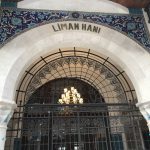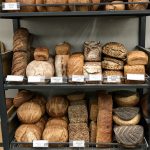For many people one of the great unsung pleasures of a visit to Bursa will be to discover the complex network and hans and roofed alleyways that make up the city’s Kapalı Çarşı (Covered Market), an altogether calmer and more authentic place to shop that its much more feted İstanbul counterpart. The local authorities have worked hard to renovate the various structures that make up the market, partly to turn some of the open-air sections into all-weather shopping areas, a wise idea given that the huge glass pyramid of the undercover Zafer Plaza Shopping Mall is only a stone’s throw away down the hill.
Like İstanbul’s Kapalı Çarşı, Bursa’s is not particularly conspicuous from the main road, being tucked away behind the magnificent Ulu Cami, a multi-domed extravaganza dating back to the last years of the 14th century. It’s from the north side of this mosque that you plunge into the lively market, coming almost at once to the Emir Han, a pretty two-storied structure that dates back to 1336. Hans were the urban equivalent of the great caravanserais that punctuated the trade routes across the country. Merchants would arrive at them with their animals and merchandise in tow and would be able to stable the animals, store the merchandise and find a bed for the night all in the one handy location. The rooms of the hans usually opened off a central courtyard with the animals sleeping downstairs and their owners upstairs. The largest came with their own mescids which usually formed the focal point of the courtyard. The Emir Han lacks a place of worship, which means more space for the tea gardens that make perfect places to rest when the shopping bags get too heavy.
Beyond the Emir Han lies the Kapalı Çarşı proper with, tucked inside just as in istanbul, the 15th-century bedesten (market hall) with its huge lockable metal doors. Here jewellers still congregate to tour their wares, much of it the gold that locals give as gifts at wedding and circumcision parties. Badly damaged by fire in 1958, the bedesten was largely rebuilt in 1960. As for the Kapalı Çarşı itself, this is a great place to shop for reasonably priced clothes, shows and household goos. Most of what’s on sale is primarily of interest to locals but you might want to look for the Aynalı Çarşısı (Mirrored Market), a corner of the bazaar housed inside what was once an old hamam that contains several lovely antique shops. It’s a great place to scout out original and replica Karagöz shadow puppets since Bursa has had a long association with the art (and indeed has a museum devoted to puppetry in the Çekirge suburb).
The streets surrounding the Kapalı Çarşı are also worth exploring, especially if you’re in need of new towels or the sort of thick bathrobes (bornoz) for which Bursa is famous. Otherwise you might want to head west in search of the Eski İpek Hanı (Old Silk Han), a building dating back to the 15th century where silk merchants used to congregate, which has somehow managed to mislay the 12-sided mescid that used to adorn its courtyard. Beyond it lies the enormous Pirinç Han (Brass Han) dating back to 1508, which is filled with fast-food restaurants – Bursa’s han network is so extensive, basically, that it’s able to provide something for just about everyone.
Heading east from the Kapalı Çarşı you’ll come to the restored 15th-century Geyve Han and then to the Yorgancılar Çarşısı, which, as it names suggests, was once used for the sale of thick local quilts designed to get locals through the icy winters, although nowadays it’s awash with all sorts of furniture as well. Even further east along Uzun Çarşı, the main drag, you’ll see the imposing stone gateway that leads through to the best known of the hans, the Koza Han (Cocoon Han), which is where the majority of the silk merchants used to gather every summer to argue over their wares. Today the courtyard around the central mescid is filled with places to sip a çay in the shadow of ancient and legally protected plane trees. Upstairs, the rooms where the merchants would have bedded down for the night are now devoted to the sale of silk scarves in every colour and pattern imaginable, also all of them imported from China.
The Koza Han may be pretty familiar, mainly because it has a southern entrance that opens onto Atatürk Caddesi, the main drag. The 15th-century Fidan Han (Plant Han), on the other hand, is only accessible from within the market itself, which means that even though it’s just as lovely (and has a gem of an elderly tea-house) it receives considerably fewer foreign visitors.
That’s as far as most outsiders ever get but if you continue walking eastwards you will come to the area of the Tuz Pazarı (Salt Market), much of which has now been roofed over to protect its many small clothes shops. If you duck down the side alleys here towards the Tuz Pazarı Cami (Salt Market Mosque) you’ll find some wonderful grocery stalls piled hight with the freshest of fruits and vegetables and the chestnuts that are a local delicacy. Here, too, you will be able to inspect the Tuz Han (Salt Han, 1454) which was given a new lease of life in 2007; pictures by the entrance record the transformation.
The Tuz Pazarı segues neatly into the renovated Okçular Carşisı (Archer’s Market) and yet more clothes and show stalls. here something like the original Beyoğlu Beautification Project of the early 2000s has been attempted, with all the shops required to adopt the same colour fascias. It remains to be seen how log that will last given that the signboards of İstiklal Caddesi are now just as chaotically individual as they were before the effort to force them into conformity.
Work on renovating the hans is scheduled to cross over İnönü Caddesi and head into the Demirciler Çarşısı (Ironworkers’ Market) where the Eskişehir Han (Old City Han) is next in line for a makeover. Nor need you stop your explorations there. Behind the glitzy Zafer Plaza stands the 18th-century Apolyont Han where visitors are invited to view one of the carriages that shoppers would once have used to reach it. And across Atatürk Caddesi, tumbling down from the remains of the castel, the ruins of the Balıkçı (Fishermen’s) and Balıbey Hans have been rebuilt to provide a series of tea gardens.
Written: March 2010, slightly edited 2024


